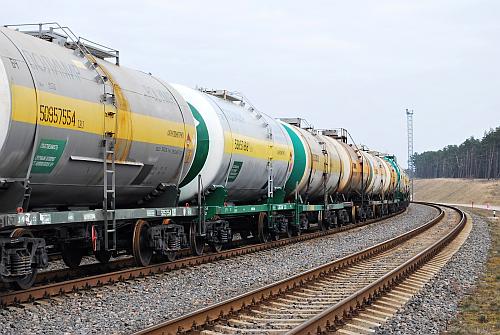 Geneva
Geneva The transport of dangerous goods remains a subject of deep concern for the fifty-six countries of the Economic Commission for Europe.
The United States Department of Transportation estimates the number of hazardous materials shipments in the United States at more than 800,000 per day, with 500,000 daily shipments involving chemicals, 300,000 involving petroleum products, and 10,000 involving miscellaneous hazardous goods.
Statistical data collected in the European Union (EU 15) in 2002 showed that transport of dangerous goods represented 111 billion tonne-km with a regular increase of 13% per year, 58% of these dangerous goods being carried by road.
Thanks to a sophisticated regulatory system, accidents happen rarely, but the derailment of a wagon carrying flammable gases in Viareggio, Italy, in 2009, served to remind authorities that accidents may still happen with catastrophic consequences.
The capsizing of the tank-vessel Waldhof, loaded with sulphuric acid, on the Rhine in January 2011 considerably disturbed navigation traffic on the Rhine for nearly one month and showed that the transport safety level could still be challenged.
A roundtable organized during the policy-oriented segment of the Inland Transport Committee on 1 March discussed the main challenges for future developments in this regulatory area, with presentations from competent authorities of UNECE Governments, the International Maritime Organization (IMO), the Central Commission for the Navigation of the Rhine (CCNR), the European Commission, the European Chemical Industry Council (CEFIC), the International Road Transport Union (IRU), and the International Union of Railways (UIC).
The discussions showed that:
- The mechanisms put in place by the United Nations to regulate the transport of dangerous goods by all modes of transport at global and regional levels, managed by the UNECE in cooperation with specialized agencies such as IMO and regional organizations such as the Intergovernmental Organization for International Carriage by Rail (OTIF) or CCNR, are efficient and lead to a high level of safety when effectively implemented by Governments;
- Governments recognize the necessity of multimodal harmonization but consider that harmonization has already been achieved for inland transport in Europe in countries which apply UNECE’s legal instruments (RID, ADR and ADN). To facilitate Euro-Asian transport, the harmonization of SMGS, applicable in Eastern Europe and Asia, with RID, applicable in Western and Central Europe, the Middle East and North Africa, would be highly desirable. Further harmonization between inland transport and maritime and air transport instruments should not jeopardize safety. Some air or sea transport requirements, which are more stringent than inland transport requirements, are justified from the safety standpoint;
- Technical assistance would be needed to help countries with economies in transition and neighbours of UNECE countries to put in place appropriate legislation and administrative structures to implement available UNECE legal tools or to join international legal instruments;
- Training, including training of competent authorities, is an important factor of safety and security, and more efforts should be made to ensure the availability of expertise in governmental administrations and the training of all participants in the chain of transport of dangerous goods. Requiring entities involved in sea or air transport of dangerous goods to use the services of dangerous goods safety advisers, as currently required for inland transport in Europe, should be envisaged.
Presentations are available at http://www.unece.org/trans/events/2011/inlandtransport_2011.html
For more information, please contact:
Mrs. Eva Molnar
Director
or
Director
or
Mr. Olivier Kervella
Chief, Dangerous Goods and Special Cargoes Section
UNECE Transport Division
Phone: +41 (0)22 917 24 01
E-mail: [email protected]
Chief, Dangerous Goods and Special Cargoes Section
UNECE Transport Division
Phone: +41 (0)22 917 24 01
E-mail: [email protected]
Note to editors
UNECE provides secretariat services to the United Nations Sub-Committee of Experts on the Transport of Dangerous Goods which elaborates and keeps up-to-date recommended Model Regulations on the Transport of Dangerous Goods. These Model Regulations are transposed into all major legal instruments regulating the international transport of dangerous goods by air, sea, road, rail and inland waterways as well as into national legislation of many countries throughout the world.
UNECE manages two regional legal instruments:
- ADR: European Agreement concerning the International Carriage of Dangerous Goods by Road (ADR) (47 Contracting Parties)
- ADN: European Agreement concerning the International Carriage of Dangerous Goods by Inland Waterways (ADN) (16 Contracting Parties) (in cooperation with CCNR)
UNECE also cooperates with OTIF to ensure harmonization of ADR and ADN with the Regulations concerning the International Carriage of Dangerous Goods by Rail (RID) (42 Parties)
The requirements of ADR, ADN, and RID are also applicable to domestic traffic in the European Union (Directive 2008/68/EC).
Ref: ECE/TRANS/11/P02